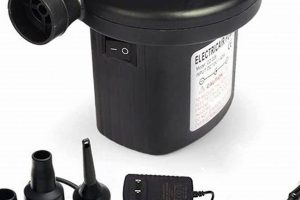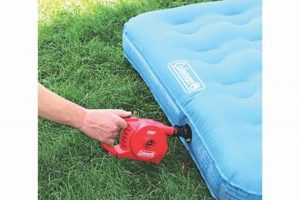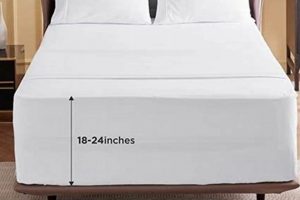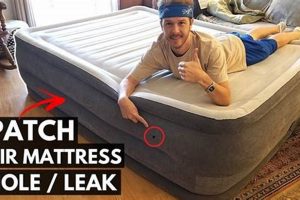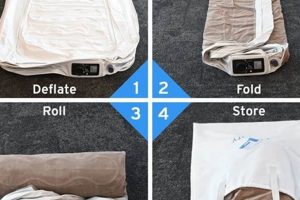The act of repairing a breach in an inflatable sleeping surface is a practical skill. This process typically involves identifying the location of the damage, preparing the surrounding area, and applying a suitable adhesive or patching material to restore the integrity of the mattress.
Addressing damage to inflatable sleeping surfaces is crucial for maintaining their functionality and extending their lifespan. A properly executed repair prevents air leakage, ensuring a comfortable and supportive sleeping experience. This also avoids the cost of frequent replacements, offering an economical alternative.
The following sections will outline the necessary materials, provide step-by-step instructions for locating the puncture, and describe various methods to effectively seal the opening, thus restoring the inflatable mattress to its intended use.
Guidance on Mending an Inflatable Mattress Puncture
Effective repair of an inflatable mattress puncture requires careful attention to detail and the use of appropriate techniques. The following guidelines offer practical advice for achieving a durable and lasting mend.
Tip 1: Thoroughly Clean the Affected Area: Prior to any repair attempt, the area surrounding the puncture must be meticulously cleaned. Use a mild detergent and water solution to remove dirt, oils, and debris. Ensure the surface is completely dry before proceeding.
Tip 2: Precisely Locate the Puncture: Immerse the inflated mattress section by section in water, observing for rising air bubbles. Mark the exact location of the leak with a permanent marker once identified. Soapy water can also aid in visualization.
Tip 3: Utilize Appropriate Adhesive or Patch Material: Select an adhesive specifically designed for flexible plastics, such as vinyl repair glue. Alternatively, employ a patch kit formulated for inflatable mattresses. Ensure the patch is larger than the puncture to provide adequate coverage.
Tip 4: Apply Even Pressure During Adhesion: After applying the adhesive or patch, apply consistent and firm pressure to the repaired area for the recommended duration, typically several minutes. This promotes proper bonding and prevents air leakage.
Tip 5: Allow Sufficient Curing Time: Permit the adhesive or patch to fully cure according to the manufacturer’s instructions before reinflating the mattress. Premature inflation may compromise the bond and necessitate re-repair.
Tip 6: Reinforce Vulnerable Areas: For larger punctures or areas prone to stress, consider applying multiple layers of patching material for added reinforcement. Overlapping patches can distribute pressure and enhance durability.
Tip 7: Test Thoroughly After Repair: Following the curing process, fully inflate the mattress and monitor for any signs of air leakage. Re-immerse the repaired area in water to confirm the seal’s integrity. Repeat the repair process if necessary.
Successful completion of these steps increases the likelihood of a long-lasting repair, ensuring the continued usability and comfort of the inflatable mattress. Proper execution minimizes the need for replacement and extends the product’s lifespan.
The next section will delve into preventative measures aimed at minimizing the occurrence of punctures, thereby prolonging the life of the inflatable mattress.
1. Surface Preparation
The process of mending an inflatable mattress hinges significantly on adequate surface preparation. This initial step directly influences the longevity and effectiveness of the repair, ensuring a secure bond between the patching material and the mattress surface. Without proper attention to this preliminary stage, the repair is likely to fail, resulting in continued air leakage.
- Cleaning and Degreasing
Contaminants such as dirt, oils, and residues impede adhesive bonding. A thorough cleaning with a mild detergent and water solution removes these barriers, creating a receptive surface for the patch. Isopropyl alcohol can further degrease the area, eliminating microscopic oils that might remain. Incomplete cleaning compromises the adhesion, leading to premature patch failure and recurrence of air leakage.
- Abrasive Texturing
Slightly abrading the surface around the puncture with fine-grit sandpaper or a specialized abrasion pad enhances mechanical adhesion. This roughening increases the surface area available for bonding, providing more grip for the adhesive. Excessive abrasion, however, can weaken the surrounding material; therefore, a controlled and gentle approach is crucial. Properly textured surfaces promote a stronger and more durable bond.
- Drying and Ventilation
Moisture hinders adhesive bonding. Allowing the cleaned and abraded area to air dry completely is essential. Forced drying with a clean cloth or low-heat hair dryer can expedite this process. Adequate ventilation prevents the accumulation of residual solvents and moisture, which can compromise the integrity of the repair. A dry and well-ventilated surface maximizes the adhesive’s ability to form a strong, lasting bond.
In conclusion, meticulous surface preparation is a non-negotiable prerequisite for successfully repairing inflatable mattresses. The combined effects of cleaning, texturing, and drying create an optimal environment for adhesive bonding, ensuring a durable and leak-free repair. Neglecting these steps significantly increases the likelihood of repair failure, ultimately leading to premature mattress degradation and the need for repeated patching attempts.
2. Precise Leak Location
The effectiveness of any attempt to repair an inflatable mattress is fundamentally contingent upon accurately identifying the source of the air leak. This process, often more challenging than the repair itself, directly dictates the success and longevity of the patching endeavor. Pinpointing the exact location of the breach is not merely a preliminary step but an integral component of a comprehensive repair strategy.
- Auditory Detection Limitations
While listening for escaping air may seem intuitive, this method proves unreliable in environments with ambient noise or when dealing with minute punctures. Sound waves disperse rapidly, making it difficult to isolate the precise origin of the leak. Reliance solely on auditory cues often leads to inaccurate pinpointing, resulting in wasted effort and incomplete repairs. The subtlety of the air escape necessitates alternative, more precise methods.
- The Soapy Water Solution
The application of a soapy water solution to the inflated mattress surface offers a visual method for leak detection. The solution, when applied liberally, forms bubbles at the site of the puncture, indicating the precise location of
escaping air. This technique is particularly effective for identifying multiple leaks or those occurring in seams and corners. The size and frequency of the bubbles directly correlate with the severity of the leak, providing an objective measure for assessing the extent of the damage. - Immersion Technique Considerations
Submerging sections of the inflated mattress in water is another reliable method for leak detection. The escaping air rises to the surface as a stream of bubbles, clearly marking the location of the puncture. This technique is particularly useful for larger mattresses or those with widespread damage. However, care must be taken to ensure the mattress is thoroughly dried after immersion to prevent mold growth and material degradation. Furthermore, the presence of chemical treatments on the mattress surface may affect the visibility of the air bubbles.
- Marking and Documentation Imperative
Once the leak has been precisely located, it is imperative to clearly mark the spot with a permanent marker or other suitable instrument. This ensures that the repair is focused on the correct area and prevents the omission of any punctures. Documentation of the leak’s location, size, and nature (e.g., pinhole, tear) can inform the selection of appropriate patching materials and techniques. Accurate marking and documentation contribute to a more efficient and effective repair process.
In summary, precise leak location is not simply a preparatory measure but a critical factor determining the success of inflatable mattress repair. Employing techniques such as the soapy water solution or immersion method, coupled with careful marking and documentation, maximizes the likelihood of achieving a durable and lasting repair. Neglecting this crucial step can lead to recurring leaks and the premature failure of the mattress.
3. Appropriate Materials
The selection of suitable materials is paramount to the successful mending of breaches in inflatable mattresses. The durability and longevity of the repair are directly correlated with the compatibility and quality of the materials employed.
- Patch Composition
Patch material must exhibit flexibility and resistance to tearing and abrasion. Thermoplastic polyurethane (TPU) and polyvinyl chloride (PVC) are commonly utilized due to their inherent elasticity and adhesive properties. The patch’s thickness and weave density determine its ability to withstand internal pressure and external stressors, factors crucial for preventing recurrence of air leakage.
- Adhesive Characteristics
The adhesive employed should possess a high bond strength specifically formulated for flexible plastics. Cyanoacrylate-based adhesives (super glue) are generally unsuitable due to their brittleness and tendency to crack under stress. Instead, adhesives containing solvents like methyl ethyl ketone (MEK) or those specifically designed for vinyl repair are preferred. The adhesive must also exhibit resistance to water and temperature fluctuations to maintain its integrity over time.
- Surface Preparation Agents
The use of appropriate cleaning agents, such as isopropyl alcohol, is essential for removing contaminants that impede adhesion. Abrasive materials, like fine-grit sandpaper, may be necessary to create a textured surface, enhancing the mechanical bond between the patch and the mattress material. The selection of these agents must be carefully considered to avoid damaging the mattress surface while effectively preparing it for repair.
- Application Tools
The effectiveness of the repair is also influenced by the tools used for application. A roller or smooth, hard object aids in applying even pressure to the patch, ensuring uniform adhesive distribution and eliminating air pockets. Precision applicators or brushes may be necessary for applying adhesive to small or intricate areas. Proper tools contribute to a clean, professional finish and a more durable repair.
The convergence of these material considerations directly impacts the efficacy of the endeavor to repair an inflatable mattress puncture. Substandard or incompatible materials compromise the structural integrity of the repair, leading to premature failure and continued air loss, thereby negating the intended outcome of restoring the mattress to its functional state.
4. Secure Seal Application
The success of mending a compromised inflatable mattress hinges directly on the provision of a secure and airtight seal. This critical step dictates the functionality and longevity of the repair. Inadequate seal application renders all preceding efforts, such as surface preparation and leak identification, inconsequential.
A poorly executed seal invites the recurrence of air leakage, negating the purpose of the repair. For instance, insufficient pressure during patch application, the presence of air pockets, or the use of inadequate adhesive can compromise the bond. Real-world examples include patches lifting at the edges, resulting in gradual air loss, or adhesive failure due to inadequate surface contact. A secure seal is achieved through meticulous technique, utilizing appropriate tools to apply consistent pressure across the patch, ensuring full contact with the prepared surface. The absence of a secure seal directly translates to the continued inability to utilize the air mattress for its intended purpose, rendering the repair a practical failure. Proper drying or curing time of adhesive should be strictly followed.
Achieving a secure seal represents the culmination of the repair process. It requires adherence to established best practices and careful attention to detail. Overlooking this critical element compromises the integrity of the mended air mattress, leading to further inconvenience and the potential need for repeated repairs or replacement. The ultimate goal is to effectively restore the mattress to its intended function by ensuring a durable and airtight barrier against air loss.
5. Post-Repair Testing
Post-repair testing constitutes an indispensable phase in the process of rectifying a breach in an inflatable mattress. This evaluation serves to validate the efficacy of the performed repair and ensures the restoration of the mattress’s intended functionality. Without rigorous testing, the success of the remedial work remains unconfirmed, potentially leading to continued air leakage and user dissatisfaction.
- Inflation Integrity Assessment
Following repair, the mattress must be fully inflated to its recommended pressure. This allows for the identification of any residual leaks or weaknesses in the patched area. A stable pressure reading over an extended period, typically several hours, signifies a successful repair. Conversely, a gradual decrease in pressure indicates a compromised seal requiring further attention. This assessment mirrors real-world usage conditions, ensuring the repair holds under realistic stress.
- Submersion Verification
Submerging the repaired area in water provides a visual confirmation of airtigh
tness. The appearance of air bubbles emanating from the patched location signifies a failure of the seal. This method is particularly effective in detecting minute leaks that may be imperceptible through pressure monitoring alone. The absence of bubbles confirms the successful closure of the puncture, validating the effectiveness of the adhesive and patching materials. - Stress Point Evaluation
Applying pressure to the repaired area, simulating movement and weight distribution during sleep, tests the structural integrity of the patch under stress. This evaluation reveals potential weaknesses in the bond or the patch material itself. Creaking sounds or visible distortion of the patch indicate a compromised repair. Successful completion of this test ensures the patch can withstand the rigors of normal use.
- Seam and Edge Inspection
Particular attention should be paid to the edges of the patch and the surrounding seams. These areas are prone to separation and air leakage due to stress concentration. A thorough visual inspection, coupled with tactile examination, can identify any signs of lifting or detachment. Reinforcement of these areas may be necessary to ensure long-term durability and prevent future air loss.
In conclusion, post-repair testing provides critical validation of efforts to address damage to inflatable mattresses. Through a combination of inflation monitoring, submersion, stress testing, and seam inspection, the effectiveness of the repair can be definitively established. Only through such rigorous evaluation can one ensure the restored functionality and extended lifespan of the mattress, thereby realizing the intended benefits of the repair process.
Frequently Asked Questions Regarding Air Mattress Puncture Repair
The following addresses common inquiries concerning the remediation of punctures in inflatable mattresses, providing factual information to facilitate effective repairs.
Question 1: Is it possible to effectively repair a sizable tear in an inflatable mattress?
The feasibility of repairing a substantial tear depends on the size and location of the damage. Extensive tears, particularly those near seams, are often beyond practical repair due to the stresses concentrated in those areas. Smaller tears, however, can be addressed with appropriate patching techniques and reinforcement.
Question 2: What adhesive is most suitable for patching an air mattress?
Adhesives specifically formulated for flexible plastics, such as vinyl or TPU, are generally the most effective. Cyanoacrylate-based adhesives (super glue) are unsuitable due to their rigidity and tendency to crack under pressure.
Question 3: How can the precise location of a small puncture be identified?
Submerging the inflated mattress in water or applying a soapy water solution to the surface are both effective methods. Escaping air will manifest as bubbles at the site of the puncture, revealing its location.
Question 4: Is it necessary to deflate the mattress completely before applying a patch?
Yes, complete deflation is essential to ensure proper adhesion. Air pressure within the mattress can impede the bonding process and lead to a compromised seal.
Question 5: How long should the adhesive be allowed to cure before reinflating the mattress?
The curing time varies depending on the adhesive used. Adherence to the manufacturer’s instructions is critical. Typically, a minimum of 24 hours is recommended to ensure a complete and durable bond.
Question 6: Are there preventative measures to minimize the risk of punctures?
Yes. Maintaining a clean sleeping environment, avoiding sharp objects near the mattress, and using a protective mattress cover can significantly reduce the likelihood of punctures.
In summary, successful inflatable mattress puncture repair hinges on proper preparation, material selection, and adherence to recommended procedures. While not all damage is repairable, employing these techniques can extend the lifespan of the mattress and avoid costly replacements.
The subsequent section will explore advanced repair techniques for more challenging punctures and damages.
Conclusion
The preceding discussion has elucidated the critical aspects of how to fix a air mattress hole, ranging from leak detection and surface preparation to material selection and post-repair testing. Precise adherence to these principles is paramount for achieving a durable and lasting repair. Failure to address any single element adequately can compromise the entire process, resulting in recurring leaks and diminished mattress lifespan.
Effective mitigation of inflatable mattress punctures demands diligent execution and a commitment to employing appropriate techniques. Although the methods described offer a means to restore functionality, preventative measures, such as careful handling and proper storage, remain the most effective strategy for minimizing the need for repairs. The ultimate objective should be to prolong the usability and comfort of the mattress, reducing waste and maximizing its value.


